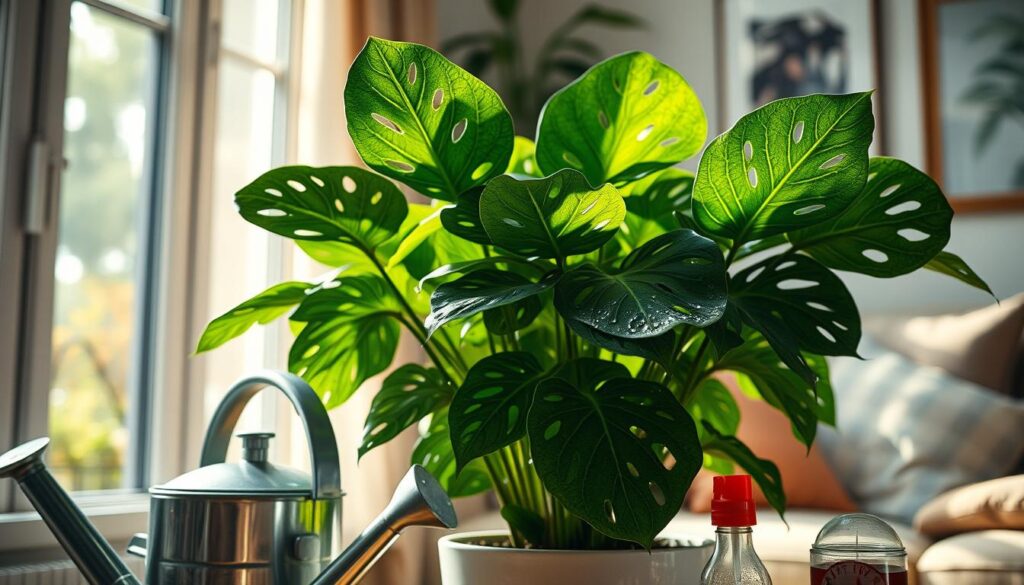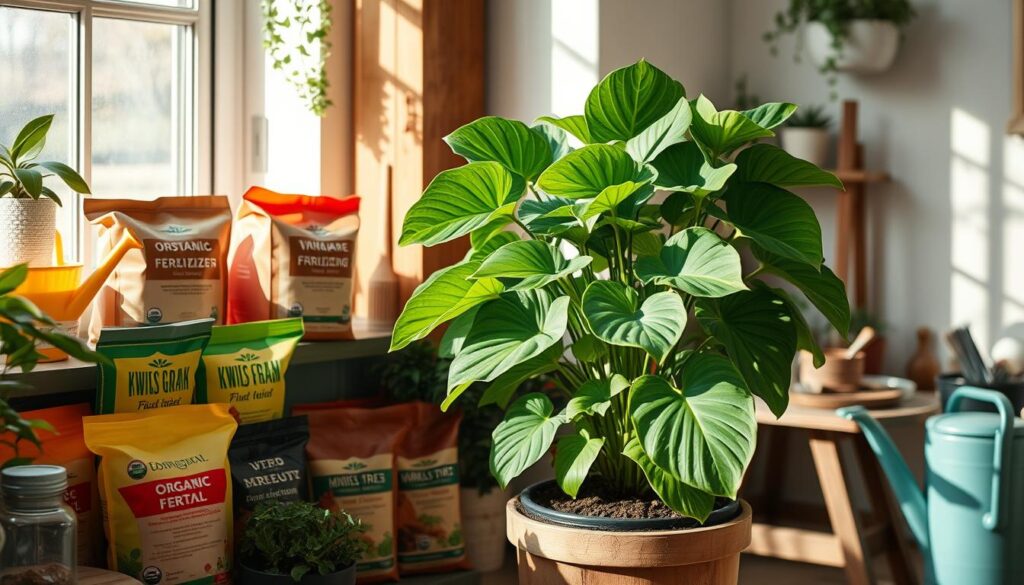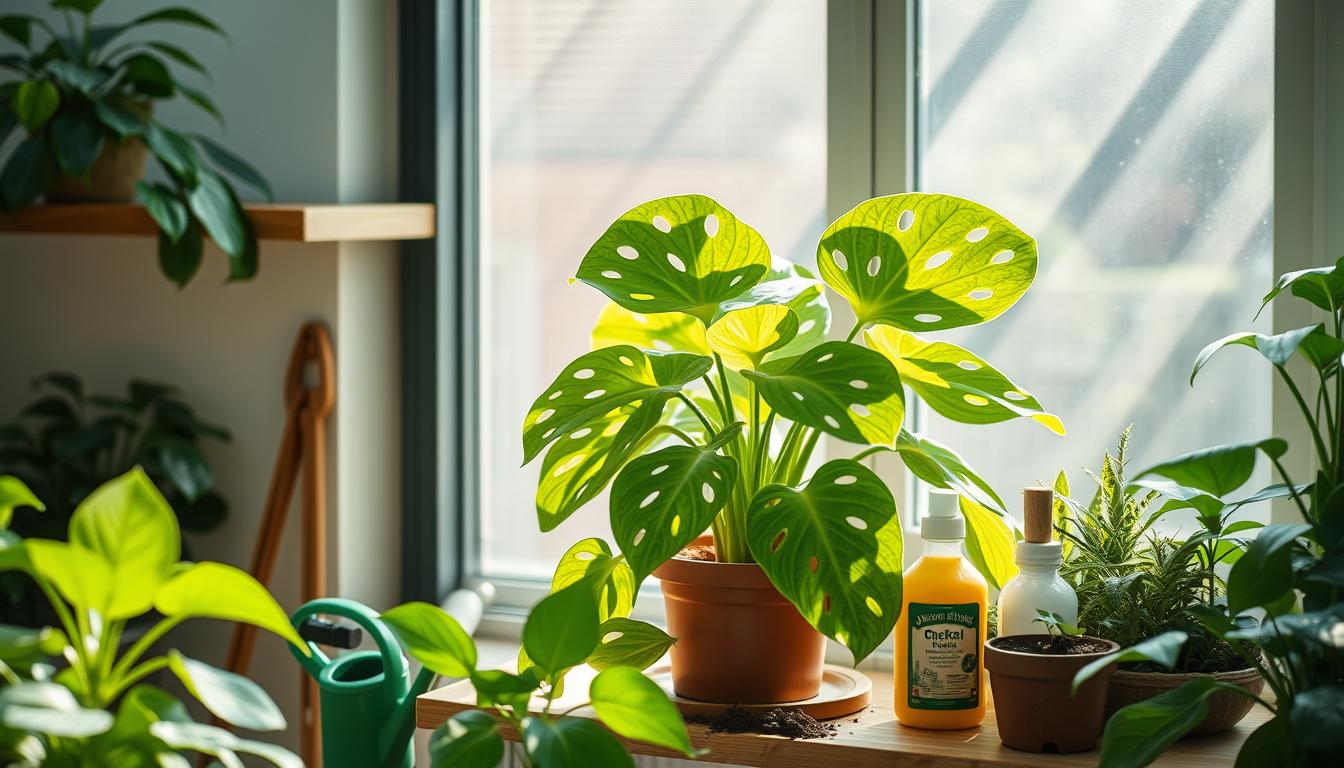Are you ready to take your indoor plant care to the next level? The Swiss Cheese Plant, also known as Monstera Deliciosa, is a stunning choice. It has big, holey leaves and is easy to care for. This makes it a favorite among indoor gardeners.
What makes this plant special? It can grow up to 20 meters tall in the wild. It also likes slightly acidic soil with a pH of 5-6. With the right care, you can enjoy its beauty at home.
Learning about Swiss Cheese Plant care opens up a world of knowledge. You’ll learn about the best conditions for your plant. This includes the right temperature, humidity, and watering schedule. By understanding these needs, you can create a perfect home for your plant.
History and Characteristics of the Swiss Cheese Plant
The Swiss Cheese Plant, also known as Monstera deliciosa, has a long history. It started in the 17th century. It grows up to 70 feet tall in the wild.
This plant has special leaves and roots. Its leaves have holes and its roots look like tentacles. They can stick to things nearby.
Pruning this plant needs care. It’s sensitive to too much cutting. A good watering schedule is also key to avoid root rot.
There are ways to make more plants. You can use stem cuttings or layering. This is helpful for those who want more Swiss Cheese Plants.
- Leaves that can reach widths of up to 18 inches
- Aerial roots that can grow tentacle-like and attach to nearby structures
- Inflorescences that measure between 8 to 12 inches long
- Fruit that can swell into a cone-like structure approximately 9 inches long
Knowing the Swiss Cheese Plant’s history and traits helps you care for it. It’s important for pruning, watering, and growing more plants. This knowledge ensures your plant thrives.
| Characteristics | Description |
|---|---|
| Leaf width | Up to 18 inches |
| Aerial roots | Grow tentacle-like and attach to nearby structures |
| Inflorescences | Measure between 8 to 12 inches long |
| Fruit | Swells into a cone-like structure approximately 9 inches long |
Choosing the Right Location for Your Swiss Cheese Plant
When picking a spot for your Swiss Cheese Plant, think about what it needs. It likes bright, indirect light. This means placing it near an east- or west-facing window. Direct sunlight can hurt the leaves.
Also, think about the humidity levels for Monstera Deliciosa. These plants love humid places, best between 60-80% humidity. You can make the air around your plant more humid by putting it on a tray with water and pebbles. Or, use a humidifier.
Temperature matters too. The best temperature is 65-75°F (18-24°C). Don’t put your plant near heating vents, fireplaces, or drafty windows. By picking the right spot, you’ll make your Swiss Cheese Plant happy and healthy.
Some key things to think about when placing your Swiss Cheese Plant include:
- Avoid direct sunlight, especially during peak hours
- Maintain a humid environment, ideally between 60-80% relative humidity
- Keep the temperature consistent, between 65-75°F (18-24°C)
Selecting the Perfect Pot and Soil
Choosing the right pot and soil is key for indoor plant care. Your Swiss Cheese Plant needs a mix that drains well. This mix should have organic matter like coco coir and perlite or vermiculite.
A big pot with holes for water is also important. A small pot can make the soil too wet. A huge pot can make the soil too dry.
- Choose a pot that is at least 1-2 sizes larger than the plant’s current pot
- Select a well-draining potting mix that is rich in organic matter
- Ensure the pot has good drainage holes to prevent waterlogged soil
- Avoid using regular garden soil, as it can compact and prevent proper drainage
By picking the right pot and soil, your Swiss Cheese Plant will grow well. Remember to change the soil and pot every couple of years. This is part of good indoor plant care.
| Pot Size | Soil Type | Drainage |
|---|---|---|
| 1-2 sizes larger than current pot | Well-draining potting mix | Good drainage holes |
Watering Your Swiss Cheese Plant
Watering is key for Swiss Cheese Plant care. The plant likes its soil to dry out before getting water again. Water it once a week, or more in spring and summer.
In the growing season, you might need to water more. But in fall and winter, water less to avoid too much water. Swiss cheese plants like their soil moist but not soggy.
Signs of Overwatering and Underwatering
Knowing when to water is important. Look out for these signs:
- Yellow leaves mean too much water or not enough nutrients.
- Leaves curling and browning show it’s too dry and sunny.
- Browning tips with yellow halos happen when it’s too dry.
Recommended Watering Schedule
Here’s a good plant watering schedule for your Swiss cheese plant:
| Season | Watering Frequency |
|---|---|
| Spring and Summer | Every 1-2 weeks |
| Fall and Winter | Every 7-10 days |

Pruning and Maintenance Tips
Pruning your Swiss Cheese Plant regularly is key. It keeps the plant looking good and growing well. Prune in the spring and summer when it’s growing fast. Use clean, sharp scissors or pruning shears to avoid diseases.
For indoor plant care, pruning is very important. It helps control the plant’s size and encourages new growth. Pruning also removes dead or damaged leaves, stopping diseases from spreading.
Here are some pruning tips for your Swiss Cheese Plant:
- Prune in the spring and summer months when the plant is actively growing
- Use clean, sharp scissors or pruning shears
- Remove any dead or damaged leaves
- Cut back long vines to maintain the plant’s shape
Regular pruning and care are vital for your Swiss Cheese Plant’s health. By following these tips, your plant will thrive and look great.
Always handle your plant with care. Avoid over-pruning, which can stress and harm the plant. With proper pruning and care, your Swiss Cheese Plant will be a stunning addition to your home. And with the right indoor plant care, it will keep growing and looking beautiful.
| Pruning Tips | Benefits |
|---|---|
| Prune in the spring and summer months | Promotes healthy growth and controls size |
| Use clean, sharp scissors or pruning shears | Prevents the spread of disease |
| Remove any dead or damaged leaves | Prevents the spread of disease and encourages new growth |
Fertilizing: What Your Plant Needs
Fertilizing your Swiss Cheese Plant is key. It needs plant propagation tips and the right fertilizing methods. Use a balanced fertilizer with a 10-10-10 ratio for best growth. For more info, check out Lomi or Trusted Houseplant Guide.
Here are some fertilizing tips:
- Fertilize every 2-4 weeks in spring and summer.
- Do it every other month in winter.
- Use half the amount of liquid fertilizers to avoid too much.

Watch how your plant reacts to fertilizing. Adjust as needed. With the right plant propagation tips and fertilizing, your Swiss Cheese Plant will do great.
| Fertilizer Type | Application Frequency |
|---|---|
| Balanced Liquid Fertilizer | Every 2-4 weeks |
| Granular Fertilizer | Every 2-3 months |
Pest Management for Swiss Cheese Plants
When you take care of your Swiss Cheese Plant, watch out for pests. Indoor plant care helps prevent pests. Knowing how to spot and treat pests is key to keeping your plant healthy.
Common pests include spider mites, mealybugs, and scale insects. These pests harm leaves and stems, causing them to turn yellow or droop. Check your plant often and keep new ones separate.
Using natural remedies can help fight pests. Neem oil and insecticidal soap work well against mealybugs and aphids. Also, high humidity and good air flow can stop spider mites and scale insects. With these tips, your Swiss Cheese Plant will stay healthy and strong.
Common Pests to Watch For
- Spider mites
- Mealybugs
- Scale insects
Natural Remedies and Treatments
Here are some natural ways to control pests:
- Neem oil
- Insecticidal soap
- Elevated humidity levels
- Good air circulation
Knowing about pests and how to stop them helps your Swiss Cheese Plant stay healthy. Always focus on Swiss Cheese Plant pest control and indoor plant care for the best results.
Propagation Techniques for Swiss Cheese Plants
Swiss Cheese Plants are easy to grow from cuttings. With the right care, you can have new plants soon. You can choose from stem cuttings, air-layering, or division.
To take a stem cutting, pick one with a healthy leaf node. This helps roots grow better. You can put the cutting in water or soil. Water works faster, showing roots in 1-2 weeks. Soil takes longer, up to a month.
Air-layering is another way to grow a new plant. It makes a moist spot on the stem to root without transplanting. It’s slower but keeps the plant intact. Important tips include clean tools and a node on the cutting.
Here are some tips for growing your Swiss Cheese Plant:
- Use a well-draining potting mix to prevent root rot
- Keep the soil consistently moist, but not waterlogged
- Provide bright, indirect light for optimal growth
- Maintain high humidity, ideally above 50%
Follow these tips and care for your Swiss Cheese Plant well. You’ll see new growth soon. Be patient and ask for help if you need it.
Troubleshooting Common Issues
Your Swiss Cheese Plant can live for years with the right care. Watch for signs like yellow leaves or wilting. Keep watering steady, give it bright, indirect light, and fertilize often.
By fixing problems fast and caring for your plant well, it will stay beautiful for a long time.
The Swiss Cheese Plant, or Monstera deliciosa, is a great choice for indoor plants. It has beautiful leaves and is easy to care for. Learning how to take care of it will help you grow a healthy, happy plant.
If you would like to see more of these Large Statement Houseplants check out our article HERE!





Pingback: The Ultimate Guide to Houseplants: 100 Best Indoor Plants for Every Home - Trusted House Plant Guide